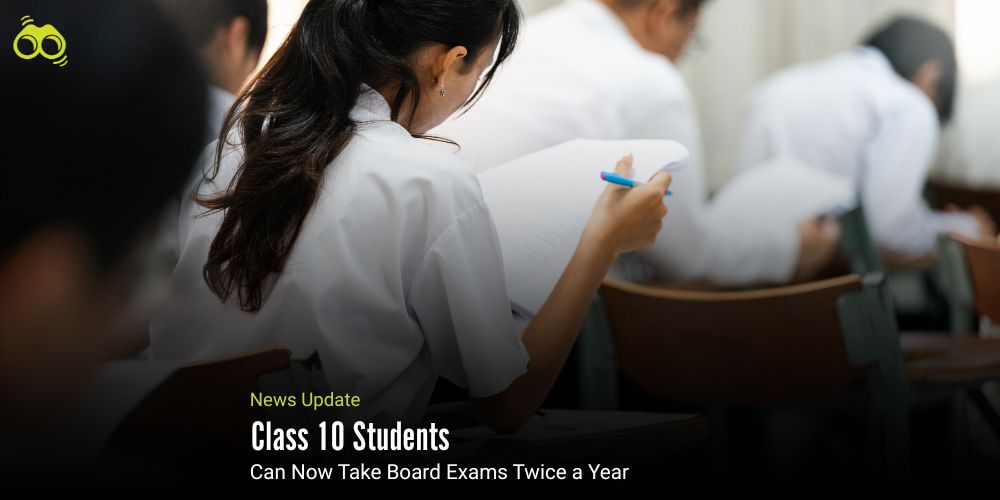India’s Board Exams Undergo Transformation: A Second Chance for Class 10 Students
Major Education Reform: Flexible Exam System to Reduce Student Stress
The Indian education system is undergoing a substantial reform aimed at mitigating the psychological stress associated with board examinations, thereby fostering a more adaptable and student-friendly learning environment. Recognising the detrimental effects of excessive academic pressure on students' mental well-being and overall health, policymakers have introduced measures to ensure a more balanced and equitable evaluation framework.
One of the most significant changes in this regard was recently announced by Union Education Minister Dharmendra Pradhan. He outlined a key revision to the Class 10 board examination structure, whereby students will now be permitted to undertake the exams twice a year. Furthermore, they will have the option to retain the higher score from their two attempts. As a result, this initiative seeks to alleviate the undue burden of a single high-stakes assessment, offering students a second chance to perform to their full potential without the anxiety of irreversible academic setbacks.
Moreover, the Ministry of Education has affirmed that this reform aligns with the government's broader objective of prioritising student well-being and academic inclusivity. Drawing inspiration from Prime Minister Narendra Modi’s “Pariksha Pe Charcha” initiative, the revised exam system aims to reduce exam-related anxiety and ensure that unforeseen challenges, such as illness or personal disruptions, do not impede a student’s academic progress. By providing two exam attempts, the policy fosters a more supportive and flexible learning environment.
Additionally, this change underscores a growing commitment towards making India’s examination system more student-centric, ensuring that academic success is not solely determined by performance on a single test day. In this context, the new exam model resembles the format used in the Joint Entrance Examination (JEE), where students are given multiple opportunities. Likewise, in the case of the Class 10 board exams, pupils will now be able to sit for two sessions in a year, with the higher of the two scores being considered final. Minister Pradhan described the approach as student-friendly, highlighting that it was introduced to enhance flexibility and improve learning outcomes. When questioned about the preparedness of teachers and infrastructure for conducting Class 10 board exams twice a year, Education Minister Dharmendra Pradhan expressed confidence in the school system’s capability. He further noted that, with over 60 school boards operating across the country, the existing framework is well-equipped and sufficiently experienced to manage the change without difficulty.
In addition to this, the Minister provided clarification regarding the National Education Policy and the three-language formula. He reiterated that no language would be imposed on any state. Furthermore, he pointed out that the system is already followed in most states, with Tamil Nadu being an exception, and dismissed objections as politically motivated. The only modification introduced is that two of the three chosen languages must be of Indian origin, while students and schools remain free to select the specific languages. Overall, the decision to hold Class 10 board exams twice a year is being regarded as a landmark reform that aims to reduce student stress while offering a second chance to improve scores, thereby advancing a more flexible and progressive education system.
Editor's Note
The decision to permit Class 10 students to appear for board examinations twice a year represents a notable shift from India’s traditional examination framework. Positioned as a student-centric reform, the policy acknowledges the substantial pressure associated with single high-stakes assessments and introduces a more flexible approach to academic evaluation. While the initiative is commendable for its focus on reducing student stress, it also raises important concerns regarding implementation. Questions remain about whether schools possess the infrastructure and resources necessary to conduct multiple examination sessions, and whether teachers can adapt to this new model without compromising the quality of instruction. Additionally, while the policy is designed to offer students a safety net, it is essential to ensure that it does not diminish academic rigour or inadvertently foster complacency.
As per skoobuzz, this reform has the potential to transform India’s examination system, shifting the emphasis from rote memorisation to holistic skill development, a long-standing goal of the country’s education sector.














0 Comments (Please Login To Continue)